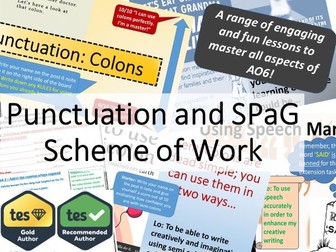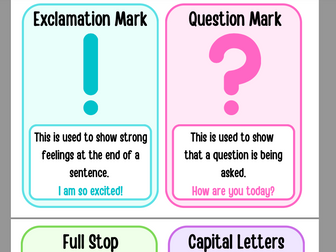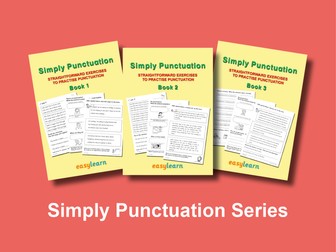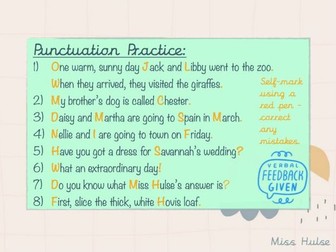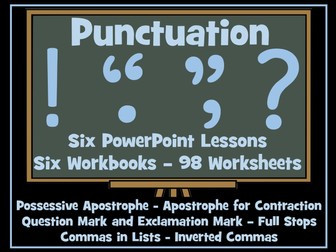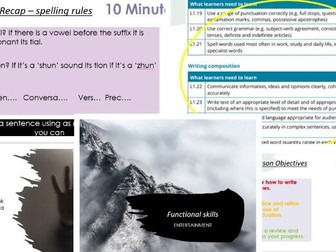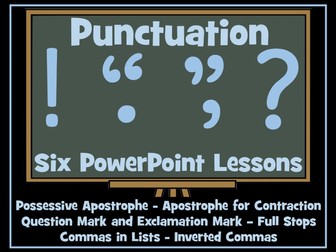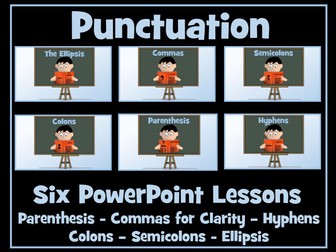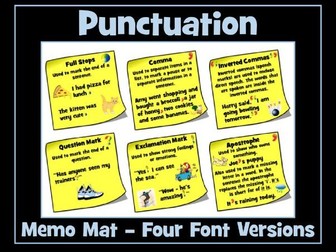
100 punctuation and grammar starters
PPt containing 100 grammar and punctuation activities with accompanying answers.
Useful for starters at KS3 or for KS2 SATs SPAG practice.

Grammar and Punctuation Revision Game
A simple but effective game which revises different parts of grammar and punctuation.
Pupils play in teams. They choose an area (eg verbs) from the game board. The PowerPoint will throw up a question about the chosen area and reveal the answer when clicked.
This activity can easily last a whole one hour lesson. Pupils enjoy the competitive element. It can be used as a ‘fun’ way to revise grammar terminology in preparation for the KS2 SATs.
Categories in the game: verbs, connectives, adverbs, subject and object, names for words (eg plural, antonym), prepositions and articles, adjectives and determiners, apostrophes, various punctuation.

Punctuation and SPaG Scheme of Work
Complete Punctuation and SPaG scheme of work for Key Stage 3 and GCSE. It’s time to win the battle against poor grammar and punctuation once and for all!
Complete unit of work which will allow your students to master advanced punctuation as well as engage with a range of exciting creative writing tasks. If you are anything like me, explicit teaching/reminding of how to properly apply punctuation is ESSENTIAL for all ability ranges, especially with the new specification GCSE placing so much emphasis on AO6.
These lessons are certainly geared more towards KS3 and KS4 students. Powerpoints are light hearted and fun, with plenty of images/colour and silly jokes to keep your students engaged and entertained. I’ve found these lessons serve as an excellent ‘crash course’ in punctuation either at the beginning of the academic year or in the run up to the GCSE exams. Below is a list of contents:
Commas (£2 if purchased on its own) -
Commas powerpoint lessons
Commas in a list worksheet
Commas in a complex sentences worksheet
Colons (£2 if purchased on its own) -
Colon powerpoint lessons
Mastering colons worksheet
Semi-Colons (£2 if purchased on its own)-
Semi-colon lesson powerpoints
Semi-colon worksheets (x2)
Semi-colon writing success criteria worksheet
Speech- (£2 if purchased on its own)
Speech powerpoint lessons
Speech worksheet
Speech mixed practice worksheet
Writing success criteria worksheet
Editing and proof reading - (£3 if purchased on its own)
Editing and proof reading mini scheme powerpoint (nearly 50 slides)
Editing and proof reading worksheets (£2 if purchased separately)
A wide range of proof reading worksheets that you can use to consolidate and improve your student’s SPaG and proof reading abilities after you have finished the unit of work.
This unit would suit a range of abilities as there is lots of scope for stretch and challenge, with ambitious success criteria and extension tasks built in throughout. Scaffolding and differentiation options are built in where appropriate.
Fully resourced and ready to roll, minimal adaptation or tweaking required.
This is obviously a SPaG/Punctuation scheme of work, but it is equally focused on creative/descriptive writing too. Much of the content is therefore ideal for teaching general creative writing skills or preparing for the fiction writing task on the new specification (9-1) GCSE English Language exam.
Grab a bargain compared to buying these resources separately.
If you loved the resource and think it’s worth 5 stars, why not get another one absolutely free?
Simply leave a review, email ireviewedajs@outlook.com with your TES username and state the free resource* you would like!
(Free resource cannot exceed the value of the original resource purchased)

Manipulating structure and punctuation for creative writing
Two engaging lesson on varying sentence structures and using punctuation for effect. Includes a range of activities and detailed worksheets that really encourage pupils to see the merit of more varied structural choices, as well as emphasises the significance of technical accuracy. Worked extremely well and had high impact on my own classes.
Suitable for both KS3 and KS4.

Punctuation
I'm using this as a reminder to pupils (and I am embarrassed to say which year they are in!) but I thought it could be useful to others.
A ppt for recapping how to use some punctuation in a sentence correctly, looking specifically at questions and statements, capital letters, and apostrophes (with omission only, not possession - that will come in another ppt later).
undefined

Spelling, grammar and punctuation training powerpoint
This slideshow is for use in a staff meeting or other training session and provides guidance for the understanding of SPAG for teachers and TAs. It includes clear explanations and examples as well as exercises and links to useful websites for further information. It can be used over more than one session, or to focus on one particular aspect of grammar or punctuation. This might be a useful reference for NQTS , or teachers new to upper KS2 especially teachers who are new to Y6.

Adding punctuation
Two paragraphs of different genres and styles that are missing all forms of punctuation.
The Activities are on a Microsoft Word document.
The resource is suitable for KS 1/2.
Focuses on the need for capital letters, full stops and commas.

PUNCTUATION Worksheet
A reminder of the different punctuation marks and a few sentences to punctuate to the right.

Commas - Punctuation and SPaG lesson
Also available as a great value scheme of work here!
If you are anything like me, you probably realise that just because students get into KS3 (and even KS4), it doesn’t automatically mean they know how to use punctuation properly, especially commas.
This is a complete PowerPoint of thoroughly planned lessons which are designed to allow students to truly master the comma and its complex uses. The activities are lively and engaging, and the PowerPoint has a fun and relevant feel to it (using memes, cracking jokes etc) so that the idea of learning about commas (again) doesn’t feel childish or lame to them.
As a minimum, you have 2 lessons worth of work here, closer to 4 if you decide to do the writing tasks thoroughly. To accompany the PowerPoint, there are two worksheets which tie in nicely to the PowerPoint and allow students to put into practice what they are being taught.
I’m guessing this is probably going to suit lower to middle ability students: those on the border who tend to really struggle with SPaG and literacy. That said, I’ve often found it necessary to do the 2nd lesson (on subordinate clauses and very complex sentences) with my top sets too.
Absolutely ready to roll and fully resourced. Very little adaptation or tweaking required as scaffolding and extension tasks are built in. Enjoy!
If you loved the resource and think it’s worth 5 stars, why not get another one absolutely free?
Simply leave a review, email ireviewedajs@outlook.com with your TES username and state the free resource* you would like!
(Free resource cannot exceed the value of the original resource purchased)

Punctuation game
In this game the child has to answer 15 questions correctly in order to get to fling their teacher.
Each question asks them to find the sentence with a mistake.
The quiz looks at question marks, speech marks, full stops and capital letters (both at the start of a sentence and for names).
Character names from the Oxford Reading Tree are used for familiarity.
I have included a link to the Flash file for you to download, or if it's easier for you a link to the game on our school website. The game has proved to be quite addictive to some of our HAs in Year 1 and to most of year 2.
Bundle

Simply Punctuation Series
The three books in this graded series will help children who struggle with punctuation and need extra practice. The series deals with punctuation basics using a very simple, straightforward format. The books include the kind of tasks that children enjoy, such as multiple choice and editing. The worksheets are ideal for preparing your pupils for grammar, punctuation and spelling tests. Book 1 covers full stops and capital letters for sentences, plus capital letters for names and ‘I’. Book 2 revises punctuation dealt with in Book 1 plus looks at question and exclamation marks and the use of commas for lists. Book 3 examines simple speech punctuation and the uses of the apostrophe for possession and some contractions. Previously sold through Easylearn.

Punctuation
PowerPoint presentation which helps students understand different punctuation marks and when to use them.
This is a visual presentation that can be printed and used as classroom display/posters.
There are two short activities for students to complete at the end of the presentation.
Punctuation marks addressed:
Full stops
Capital letters
Commas
Apostrophes
Colon
Semi-colon
Question Marks
Exclamation Marks
Hope you enjoy :)

Sentence Types and Punctuation (KS2)
This lesson is part of my SPaG (Spelling, Punctuation and Grammar - sometimes abbrieviated to GPS) collection. This lesson focuses on sentence types and punctuation, but also contains some further grammar practice. This lesson was created completely independently and was created purely to plug gaps in my pupils knowledge.
I tend to get my class to complete a baseline for SPaG, so I know where to target.
Resource bundle includes: Lesson Powerpoint (PDF) and any accompanying resources.
Slide one: Title page
Slide two: Basic punctuation learn
Slide three: Sentence learn
Slide four: Sentence types learn
Slide five: Question 1: Punctuation/Sentence Types
Slide six: Question 2: Punctuation
Slide seven: Question 15: Punctuation
Slide eight: Question 17: Sentence Types
Slide nine: Question 27: Sentence Types
Slide ten: Question 28: Punctuation
Slide eleven: Question 31: Punctuation/Sentence Types
Slide twelve: Sentence types practice
Slide thirteen: Sentence types practice feedback (answers)
Slide fourteen: Punctuation practice
Slide fifteen: Punctuation practice feedback (answers)
Bundle

Punctuation
This bundle contains six PowerPoint lessons and six workbooks on the following punctuation devices:
The Possessive Apostrophe
The Apostrophe for Omission
Commas in Lists
The Question Mark and Exclamation Mark
Inverted Comma (Speech Marks)
Full Stops
The Possessive Apostrophe
This resource contains an editable, 60-slide PowerPoint lesson on the possessive apostrophe. It explains how to use the apostrophe to show possession for singular and plural nouns. The PowerPoint provides lots of examples and opportunities for students to use the apostrophe appropriately. The presentation also includes a hyperlink to a short video on the apostrophe for possession.
The workbook contains 15 worksheets on the possessive apostrophe/apostrophe for possession for both singular and plural nouns. It also contains an information sheet on how to use apostrophes for possession.
The Apostrophe for Omission
This is an editable, 50 slide PowerPoint lesson on the apostrophe for contraction / omission. It explains how to use the apostrophe in contracted words. This resource will help students to use apostrophes appropriately in their written work and to improve their punctuation skills. The PowerPoint also contains a hyperlink to a short video explaining how to use the apostrophe for contraction.
The workbook includes an information sheet explaining when and how to use the apostrophe for omission/contraction. It also contains a variety of tasks that will help students to master using apostrophes appropriately in their written work and to improve their punctuation skills. Answers are included.
Commas in Lists
This is a fully editable, 35-slide PowerPoint lesson on using the comma in lists in sentences. The PowerPoint explains how to use the comma in lists in sentences. There are opportunities for pupils to insert the comma in the correct place. There are also opportunities for pupils to identify where the comma has been misplaced.
The 20-page workbook includes 18 worksheets and 2 information sheets on using commas to demarcate items / phrases within sentences and to separate adjectives when there are two or more describing a noun. It is an ideal independent learning pack for home learning, distance learning and remote learning. Tasks include:
inserting commas in the correct places in sentences
rewriting incorrectly punctuated sentences
composing own sentences containing a list of items
composing own sentences using two or more adjectives
punctuating The Twelve Days of Christmas with commas
composing own lyrics for the Twelve Days of Christmas and punctuating with commas
The Question Mark and Exclamation Mark
This is an editable, 52-slide PowerPoint lesson on the question mark and exclamation mark. The presentation explains when these punctuation marks are used and gives many examples. It also provides opportunities for pupils to decide the correct punctuation at the end of a sentence - exclamation mark, question mark or full stop. The PowerPoint also contains two hyperlinks to short videos about the question mark and the exclamation mark.
The workbook contains 9 worksheets with answers and an information sheet on using the question mark and the exclamation mark. Tasks include:
Selecting the correct question word for sentences.
Deciding which punctuation device should be used at the end of sentences.
Composing sentences using question marks appropriately.
Composing sentences using exclamation marks appropriately.
Rewriting a short passage inserting the correct punctuation devices - full stop, question mark or exclamation mark.
Inverted Comma (Speech Marks)
This editable, 75-slide Powerpoint lesson on inverted commas (speech marks/quotation marks) demonstrates how to:
use inverted commas to enclose direct speech
punctuate reporting clauses and direct speech
punctuate split speech
set out dialogue in writing
use interesting words to replace ‘said’
Many opportunities are provided within the PowerPoint for pupils to punctuate direct speech.
The 22 page workbook on inverted commas contains five information/revision sheets, seventeen worksheets and an answer booklet. Tasks include:
using inverted commas to enclose direct speech
punctuating reporting clauses and direct speech
punctuating split speech
setting out direct speech in dialogue
using alternative words to ‘said’ in reporting clauses
composing writing containing direct speech
Full Stops
This editable, 50-slide PowerPoint lesson explains how and when to use the full stop and why it is important to place it accurately in writing. It also clearly demonstrates that a capital letter is needed at the start of a sentence. Ample opportunities are provided throughout the PowerPoint for pupils to decide where the full stops and capital letters should go.
The workbook contains 14 worksheets on using full stops to demarcate sentences. Tasks include:
Placing full stops at the end of simple sentences
Placing full stops in writing containing several sentences
Placing full stops in short paragraphs
Composing own sentences
Correcting sentences in which the full stops have been incorrectly placed
If you buy this resource and are pleased with your purchase, I would be extremely grateful if you could leave a review. As a token of appreciation, you can have a free resource of your choice up to the same value as your purchased resource. Just email inspireandeducate@aol.co.uk with your user name, the resource you have reviewed and the resource you would like for free.
More English Resources
Thinking of publishing your own resources or already an author and want to improve your resources and sales? Check out this step-by-step guide:
How to Become a Successful TES Author: Step-by-Step Guide

Punctuation
Functional skills lesson on punctuation, paragraphing, writing in different tenses and using this to write a review. Comes with a reading comprehension, a discussion and a recap of a spelling technique I used in a previous lessons. Lesson is complete with sample answers, extension activities and peer marking for the final written piece.
Punctuation covered: commas, full stops, exclamation marks, apostrophes and possessive apostrophes.
Bundle

Punctuation
This bundle contains six PowerPoint lessons on the following punctuation devices:
The Possessive Apostrophe
The Apostrophe for Omission
Commas in Lists
The Question Mark and Exclamation Mark
Inverted Comma (Speech Marks)
Full Stops
The Possessive Apostrophe
This is an editable, 60-slide PowerPoint lesson on the possessive apostrophe. It explains how to use the apostrophe to show possession for singular and plural nouns. The PowerPoint provides lots of examples and opportunities for students to use the apostrophe appropriately. The presentation also includes a hyperlink to a short video on the apostrophe for possession.
The Apostrophe for Omission
This is a 50 slide PowerPoint lesson on the apostrophe for contraction / omission. It explains how to use the apostrophe in contracted words. This resource will help students to use apostrophes appropriately in their written work and to improve their punctuation skills. The PowerPoint also contains a hyperlink to a short video explaining how to use the apostrophe for contraction.
Commas in Lists
This is 35-slide PowerPoint lesson explains how to use the comma in lists in sentences. There are opportunities for pupils to insert the comma in the correct place. There are also opportunities for pupils to identify where the comma has been misplaced.
The Question Mark and Exclamation Mark
This editable, 52-slide PowerPoint lesson on the question mark and exclamation mark explains when these punctuation marks are used and gives many examples. It also provides opportunities for pupils to decide the correct punctuation at the end of a sentence - exclamation mark, question mark or full stop. The PowerPoint also contains two hyperlinks to short videos about the question mark and the exclamation mark.
Inverted Comma (Speech Marks)
This editable, 75-slide Powerpoint lesson on inverted commas (speech marks/quotation marks) demonstrates how to:
use inverted commas to enclose direct speech
punctuate reporting clauses and direct speech
punctuate split speech
set out dialogue in writing
use interesting words to replace ‘said’
Many opportunities are provided within the PowerPoint for pupils to punctuate direct speech.
Full Stops
This 50-slide PowerPoint lesson explains how and when to use the full stop and why it is important to place it accurately in writing. It also clearly demonstrates that a capital letter is needed at the start of a sentence. Ample opportunities are provided throughout the PowerPoint for pupils to decide where the full stops and capital letters should go.
Click on the individual links for further details
These resources are suitable for Key Stage 2 pupils and older SEN pupils who find sentence demarcation and punctuation challenging.
If you buy this resource and are pleased with your purchase, I would be extremely grateful if you could leave a review. As a token of appreciation, you can have a free resource of your choice up to the same value as your purchased resource. Just email inspireandeducate@aol.co.uk with your user name, the resource you have reviewed and the resource you would like for free.
You may also be interested in:
Punctuation PowerPoint Lessons and Workbooks Bundle
This resource contains all the PowerPoint lessons and six workbooks containing 98 worksheets in total.
More English Resources
Thinking of publishing your own resources or already an author and want to improve your resources and sales? Check out this step-by-step guide:
How to Become a Successful TES Author: Step-by-Step Guide
Bundle

Punctuation
This bundle includes six PowerPoint lessons on punctuation - parenthesis (commas, dashes, brackets), commas to clarify meaning, colons, semicolons, hyphens and the ellipsis.
All the PowerPoints clearly explain the functions of each punctuation mark and how they are used. Many opportunities are provided within the PowerPoints for pupils to identify when they should be used and to place them correctly in writing.
All the PowerPoints contain links to short videos that also explain and give example of how they are used.
Parenthesis - 55 slides
The Ellipsis - 45 slides
Hyphens - 60 slides
Colons - 60 slides
Semicolons - 45 slides
Commas to Clarify Meaning-50 slides
If you buy this resource and are pleased with your purchase, I would be extremely grateful if you could leave a review. As a token of appreciation, you can have a free resource of your choice up to the same value as your purchased resource. Just email inspireandeducate@aol.co.uk with your user name, the resource you have reviewed and the resource you would like for free.
You may also be interested in:
Punctuation Workbooks Bundle

Punctuation
This resource contains a succinct, colourful and highly visual punctuation memo mat reminding pupils of how and when to use the punctuation devices - the full stop, comma, possessive apostrophe, apostrophe for omission/contraction, speech marks / inverted commas, the question mark and exclamation mark.
The mat could be laminated and used by pupils for general use in their writing or placed in their files for reference. It could be enlarged to A3 size and used for display purposes.
This resource is appropriate for Year 1 - 6 pupils and older SEN / Entry Level pupils who may find sentence demarcation challenging and have yet to master the basics in punctuation and writing.
More Punctuatuon Resources
Thinking of publishing your own resources or already an author and want to improve your resources and sales? Check out this step-by-step guide:
How to Become a Successful TES Author: Step-by-Step Guide

Punctuation
Great resources to help learners understand where punctuation should be used. The pre-prepared writing is construction based but can be adapted to meet the needs of your learners, alternatively get them to create a story about any topic they want including the punctuation they need. The worksheet has gaps for them to fill in, this can be done as plenary or starter activity the next lesson.

